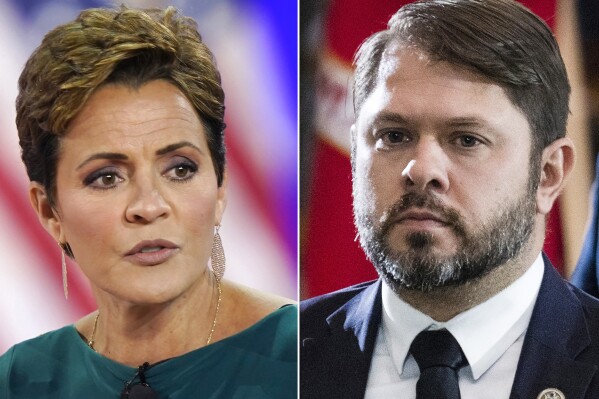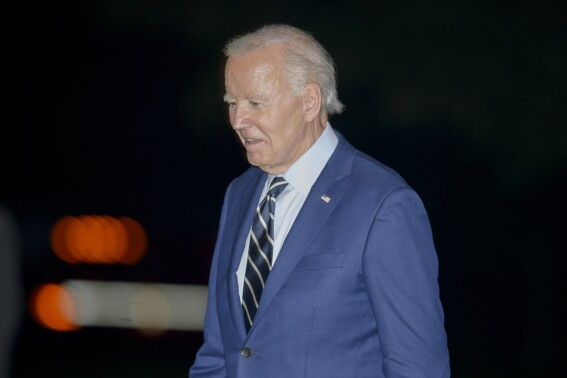NEW YORK (AP) — Nearly a decade into the Trump Era of politics, less than a month from his third Election Day as the Republican candidate for president and there is still remarkably little consensus within the media about how best to cover Donald Trump.
Are reporters “sanewashing” Trump, or are they succumbing to the “banality of crazy?” Should his rallies be aired at length, or not at all? To fact-check or not fact-check?
“If it wasn’t so serious, I would just be fascinated by all of it,” said Parker Molloy, media critic and author of The Present Age column on Substack. “If it didn’t have to do with who is going to be president, I would watch this and marvel at how difficult it is to cover one person who seems to challenge all of the rules of journalism.”
Books and studies will be written about Trump and the press long after he is gone. He’s always been press-conscious and press-savvy, even as a celebrity builder in Manhattan who took a keen interest in what tabloid gossip columns said about him. Most issues stem from Trump’s disdain for constraints, his willingness to say the outrageous and provably untrue, and for his fans to believe him instead of those reporting on him.
It has even come full circle, where some experts now think the best way to cover him is to give people a greater opportunity to hear what he says — the opposite of what was once conventional wisdom.
‘Sanewashing’ creates an alternative narrative, some say
Molloy first used the phrase “sanewashing” this fall to describe a tendency among journalists to launder some of Trump’s wilder or barely coherent statements to make them seem like the cogent pronouncements of a typical politician. One example she cites: CNN distilling a Trump post on Truth Social that rambled on about the “radical left” and “fake news” into a straight news lead about the former president agreeing to debate his Democratic opponent, Vice President Kamala Harris.
At its best, polishing Trump creates an alternative narrative, she said. At its worst, it’s misinformation.
During a Wisconsin rally the last weekend of September, Trump talked of danger from criminals allowed in the country illegally. “They will walk into your kitchen, they’ll cut your throat,” he said. The New Republic writer Michael Tomasky was surprised not to find the quote in The New York Times’ and Washington Post’s coverage, although The Times noted that Trump vilified undocumented immigrants, and there were other media references to what Trump himself called a dark speech.
“Trump constantly saying extreme, racist violent stuff can’t always be new,” Tomasky wrote. “But it is always reality. Is the press justified in ignoring reality just because it isn’t new?”
One likely reason the remark didn’t get that much attention is because Trump — at the same rally — referred to Harris without evidence as “mentally disabled.”
That comment merited quick mention on the ABC and CBS evening newscasts the next day, in the context of criticism from two fellow Republicans, and after stories about Hurricane Helene’s devastation and war in the Middle East. NBC’s “Nightly News” didn’t bring it up at all.
In other words, Trump said something wild. What’s new? More than sanewashing, political scientist Brian Klaas calls that the banality of crazy, where journalists become accustomed to things Trump says that would be shocking coming from other candidates simply because they’re numbed to it.
It’s a hard fit for a daily news cycle
What to know about the 2024 Election
- Today’s news: Follow live updates from the campaign trail from the AP.
- Ground Game: Sign up for AP’s weekly politics newsletter to get it in your inbox every Monday.
-
AP’s Role: The Associated Press is the most trusted source of information on election night, with a history of accuracy dating to 1848. Learn more.
Illuminating reporting on Trump rarely fits the model of quick news stories that sum up daily developments. “This really serves the small group of news consumers that we would call news junkies, who follow the campaign day to day,” said Kelly McBride, senior vice president of the Poynter Institute, a journalism think tank. “But it doesn’t help people decide how to vote, or understand the candidate better.”
Trump critics often complain about how the nation’s leading news outlets cover him. But they sometimes overlook attempts to bring perspective to issues they’re concerned with. The Times, for example, used a computer to compare his speeches now with older ones in a story Sunday, and similarly had a Sept. 9 examination of questions about Trump’s age and mental capacity. The Post has written about how Trump doesn’t mention his father’s Alzheimer’s Disease as he attacks others about mental capacity, and distortions about a cognitive test he took. The Associated Press wrote of Trump’s Wisconsin rally that he “shifted from topic to topic so quickly that it was hard to keep track of what he meant at times.”
“Trump is a really difficult figure to cover because he challenges news media processes every day, has for years,” The Times’ Maggie Haberman, one of Trump’s best-known chroniclers, told NPR last month. “The systems ... were not built to deal with somebody who says things that are not true as often as he does or speaks as incoherently as he often does. I think the media has actually done a good job showing people who he is, what he says, what he does.”
Press critics may instead be frustrated that the work doesn’t have the impact they seek. “The people who don’t like or are infuriated by him cannot believe his success and would like the press to somehow persuade the people who do like him that they are wrong,” said Tom Rosenstiel, a journalism professor at the University of Maryland. “And the press can’t do that.”
Fact-checking is a bone of contention
One of the central issues surrounding the three general election debates was how, or whether, the television networks would fact-check the candidates in real time on the air.
CNN didn’t during Trump’s debate with President Joe Biden last spring. When ABC’s moderators corrected Trump four times during his September debate with Harris, the former president’s supporters were infuriated. CBS News sought a middle ground during the vice presidential debate, and learned how hard it is to satisfy everyone.
“F you CBS — how DARE YOU,” Megyn Kelly posted on X when CBS briefly cut JD Vance ‘s microphone after correcting him on a comment about immigrants. Salon media critic Melanie McFarland wrote that the people best equipped to point out truth “barely rose to that duty.”
The fact-check industry flourished during Trump’s years in office, the number of such websites devoted to that duty jumping from 63 in 2016 to 79 in 2020, according to the Duke Reporters’ Lab. Yet limitations were also exposed: Republicans demonized the practice, to the point where many Trump supporters either don’t believe those who try to referee what’s true or false, or don’t bother reading. In day-to-day reporting, it’s not enough to point out when a politician is wrong, Rosenstiel said. They must clearly explain why.
Journalists, who rarely win popularity contests to begin with, saw their collective reputations plummet under withering attacks from Trump.
In the heady days of 2015, television news networks like CNN showed Trump campaign rallies at length. It was entertaining. It drove ratings. What harm could be done?
Many later regretted that decision. Throughout his presidency and beyond, television outlets that are not Trump-friendly have grappled with the question of how much to show Trump unfiltered, and still haven’t fully settled on an answer. CNN shows Trump at rallies on occasion, rarely at length.
But in a back-to-the-future move, some experts now say it’s best to let people hear what Trump says. Poynter’s McBride praised The 19th for a story on child care when, frustrated by an attempt to clarify Trump’s positions with his campaign, the website simply printed a baffling 365-word direct quote from Trump when he was asked about the issue.
While fact checks and context have their place, there’s value in presenting Trump in the raw. “Showing Trump at length is not sanewashing,” Rosenstiel said.
Molloy admitted to some surprise at how much traction her original column on sanewashing received. It may reflect a desire to define the undefinable, to figure out what the news media still hasn’t been able to after all this time. She notes the politicians who try to emulate Trump but fail.
“They don’t have what makes him Donald Trump,” she said. “People can look at it as part of his brilliance and people can look at it as him being crazy. It’s probably a little of both.”
___
David Bauder writes about media for the AP. Follow him at http://x.com/dbauder.
What to know about the 2024 Election
- Today’s news: Follow live updates from the campaign trail from the AP.
- Ground Game: Sign up for AP’s weekly politics newsletter to get it in your inbox every Monday.
-
AP’s Role: The Associated Press is the most trusted source of information on election night, with a history of accuracy dating to 1848. Learn more.
Disclaimer: The copyright of this article belongs to the original author. Reposting this article is solely for the purpose of information dissemination and does not constitute any investment advice. If there is any infringement, please contact us immediately. We will make corrections or deletions as necessary. Thank you.



